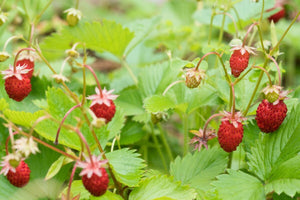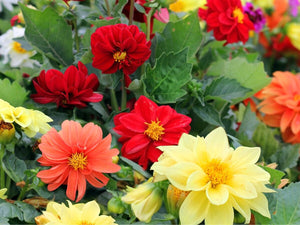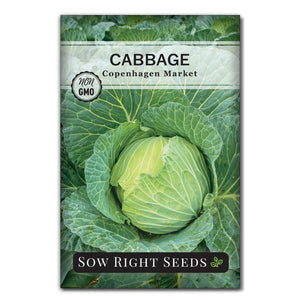Grow Perfect Cabbage at Home: Step-by-Step Guide from Seed to Harvest
CabbageIf you think gardening only happens in the summer, then cabbage will change your mind. This cold-weather crop will enjoy your garden when everything else is shivering. We’ll show you how temperature, moisture, and light make all the difference in growing tangy cabbage that forms a nice head and isn’t bitter. We’ll share what we’ve learned about growing cabbage so you can enjoy a delicious harvest.

Copenhagen Market Cabbage - Sow Right Seeds
What You'll Learn
Quick Links
How to Grow Cabbage From Seed
From the very first moment you plant a cabbage seed, it’s important to be aware of the temperature, moisture, and light for optimal growing.
Cabbage seeds are planted only ¼” deep and will germinate quickly. Once they come up, those little sprouts will be searching for light. At this point, you need grow lights close to the seedlings so they don’t stretch and grow into leggy seedlings. The problem with leggy seedlings is that as they start growing leaves, the weight will pull them over, and the plants will die. A dramatic end to your cabbage dreams. So place a grow light just a few inches away, and the plants will stay close to the soil and develop a strong main stalk.
Temperature is also important for seedlings. The warm temperatures will encourage growth. So keep the soil less than 65ºF after seeds have sprouted. There’s no need for warming mats when growing cabbage. This is a cool season crop. High temperatures will result in rapid growth, which leads to spindly seedlings.
Moisture is always crucial with young seedlings. Too much water will result in rot. Too little, and your cabbage plants will die. Misting the soil after planting and covering it with a humidity dome will keep moisture in. Once the seeds have sprouted, the cover can come off, and you can water from the bottom to avoid damping off.

Tips for fail-proof cabbage seed germination
Start cabbage seeds 6 to 8 weeks before transplanting.
Sow seeds ¼” deep.
Soil temp should be 70ºF for cabbage seed germination and then lowered to 60º to 65ºF.
Use bright grow lights close to the cabbage seedlings.
Keep soil moist by misting and using a humidity dome.
Once seeds have sprouted, water cabbage seedlings from the bottom.

Transplanting Cabbage Seedlings
Timing is important when transplanting seedlings. Cabbage seedlings should have 3 to 4 true leaves and a developed root system before transplanting outside.
Cabbages can be transplanted two or four weeks before the estimated last spring frost when temperatures are above 45ºF.
Start with hardening off the cabbage seedlings before transplanting them outdoors. Unlike warm weather crops like tomatoes and peppers, cabbage can go outside in the garden before the last spring frost. Take time to harden off your cabbage seedlings. When taking them outside, protect them from too much sun and wind.
You can thin your cabbage seedlings while transplanting them. Keep the viable ones and space them 18 to 24 inches apart. Keeping cabbage plants too close together will result in smaller heads.
Bury the cabbage seedlings to the same depth that they were already growing.
Two weeks after transplanting, you can start fertilizing your cabbage plants. Use a balanced fertilizer such as a 10-10-10. Avoid fertilizers with extra nitrogen after the heads have formed, as it can cause splitting.
When cabbage seedlings are young, they are cold-sensitive. With temperatures below 45ºF for more than a few days, they will bolt or have looser heads depending on where they are in their growth. You can cover cabbage plants to protect them from cold weather. But remove the cover when the heat of the day will warm them up.
This young stage is the perfect time to use row covers to protect cabbage seedlings from insects, wind, and extreme temperatures.


Heirloom Cabbage Varieties to Grow
There are two groups of cabbage, loose-heading and hard-heading. As the names suggest, the hard-heading cabbages form a compact head of leaves. The loose-heading types will have a loose group of leaves. Cabbage can be dark green to white, and some varieties are red or purple. These color differences will have some different nutrient amounts. Savoy types, with crinkly leaves, will have more iron.
Jersey Wakefield heirloom cabbage has a compact, pointed head. These cabbage plants can be planted close together and have a mild, sweet flavor

Chinese cabbage, such as Michihili and Bok Choy, does best in fall gardens. It’s more sensitive to spring frost and hot temperatures in summer. So planting in the warmth of summer and allowing it to mature in cooler fall is ideal.
How to Grow Cabbage Plants
Successfully growing cabbage requires attention to the same basic requirements needed for seed germination. The right temperature, plenty of sun, and a steady supply of water and nutrients will keep cabbage growing without stress.
Temperature:
Cabbage thrives in cooler temperatures between 45º and 80ºF with full sun. More mature cabbage plants can withstand temperatures as low as 20º. That’s why growing cabbages in early spring or fall is recommended in most locations. When temperatures get too hot or too cold before the heads have formed, then the cabbage plants will bolt and go to seed.
Watering:
Cabbage plants will need 1 to 2 inches of water a week. Water cabbage plants thoroughly so that the water goes down into the soil to about 6 inches deep. The top inch can be dry before watering again. Avoid overhead watering as this can keep leaves wet and make them susceptible to mildew and diseases. Heavy rain close to harvest time can cause heads to split.
Weeding:
Cabbage plants don’t have very deep roots, so weeds can easily compete with them. Keep the weeds down by using mulch. When pulling weeds, use tools to cut off the weeds at the surface level to avoid exposing or disturbing cabbage roots.
Fertilizing:
Cabbage is a heavy feeder. It needs a steady supply of nutrients to grow all those nutritious leaves. Right after transplanting or thinning, you can apply extra nitrogen. Well-rotted compost is also a great way to add the extra nutrients it needs.
Mulching:
Organic mulches such as grass clippings and straw are a great way to control weeds and retain moisture.

Solutions for Cabbage Pests & Diseases:
Pests and diseases are always a frustration for gardeners. But fortunately, there are ways to keep them from overtaking your cabbage harvest.
Common cabbage pests are aphids, cabbage worms, cabbage loopers, cabbage maggots, diamondback moths, and flea beetles. Keep an eye out for pests. The white butterflies that you find in the garden are harmful to cabbages and all cruciferous veggies. Plants can be dusted with BT dust to help control these.
Using row covers can help protect young cabbage plants from these pests. Cover plants early in the growing season before the pests have a chance to find your new cabbages.
Companion planting can also be used to deter and lure pests from the cabbage.
Common diseases that afflict cabbage are Alternaria, black rot, and clubroot. Avoiding overhead irrigation and keeping a soil pH between 6.5 and 6.8 and help mitigate these problems.

Harvesting Cabbage
This is what you’ve been waiting for! Time to harvest those cabbage heads. Cabbage is ready to harvest when the head is of adequate size. An adequate-sized head can vary between different varieties. The head should be dense and firm.
To harvest a head of cabbage, use a sharp knife to cut it off above the outer leaves.
When cabbage heads are almost ready to be harvested, heavy rain can cause the heads to split because they take up too much water. Cutting some of the roots or twisting the head slightly will keep it from taking up as much water.
Mature cabbage plants can tolerate overnight low temperatures. But if temps drop below 25ºF, you will need to protect them with covers.
Once harvested, cabbage needs to be stored in a cold, moist place. Temperatures between 32º to 40ºF and 95% humidity is ideal way to store cabbage. You can wrap cabbage heads in wet paper towels to increase humidity and store them in the fridge. Don’t store cabbage with apples and other ethylene-producing fruit.
Cabbage is a healthy vegetable that can be used in various ways. Cabbage is low in calories, has no fat, and is high in vitamin C, fiber, calcium, iron, and folic acid. It is also noted for its natural cancer-fighting chemicals.
All kinds of cabbage are enjoyed raw and cooked. Cabbage can be used as the filling or as the wrapper around other ingredients. Also, fermenting is a delicious way to preserve cabbage. Sauerkraut and kimchi are popular options for making fermented cabbage.

Companion Plants for Cabbage
Companion plants are a helpful way to deter common pests.
Nasturtiums attract aphids and can be planted next to cabbages to keep aphids off cabbages. They also help deter cabbage worms.
Planting peas and beans the year before will put nitrogen back into the soil.
Radishes can also be planted near cabbage to trap flea beetles.

Common Cabbage Questions
Why didn’t a head form on my cabbage plant?
No head formation can be a result of a few things. If it got too hot, the cabbage bolted before it formed a head. Another reason could be damage to the central interior of the plant.
The cabbage was ready to harvest, and then the head split.
Once the cabbage is ready to harvest, too much water can split the head. To avoid this happening to your crop, limit the water. Since we can’t control the rain, you can twist the head a quarter turn or chop some of the roots to keep the cabbage head from taking up as much water.
Is it better to direct sow or transplant cabbage?
Sowing seeds indoors and then transplanting will give you a head start on spring growing. It will also allow you to control the seed starting and young seedling stage for better success.
Does cabbage regrow after cutting?
Hard-heading cabbages can grow side shoots after harvesting the main head. Chinese cabbage, like pak choi, can produce more leaves when you harvest the outter leaves.

Growing cabbage from seed is a rewarding experience that gives you full control over the quality and variety of your harvest. By providing the right temperature, consistent moisture, and proper nutrients, you’ll be on your way to growing firm, flavorful cabbage heads straight from your garden. Don’t settle for store-bought when you can enjoy the taste and satisfaction of homegrown cabbage! Start your garden today with heirloom cabbage seeds from Sow Right Seeds —shop now and grow with confidence!








Leave a comment